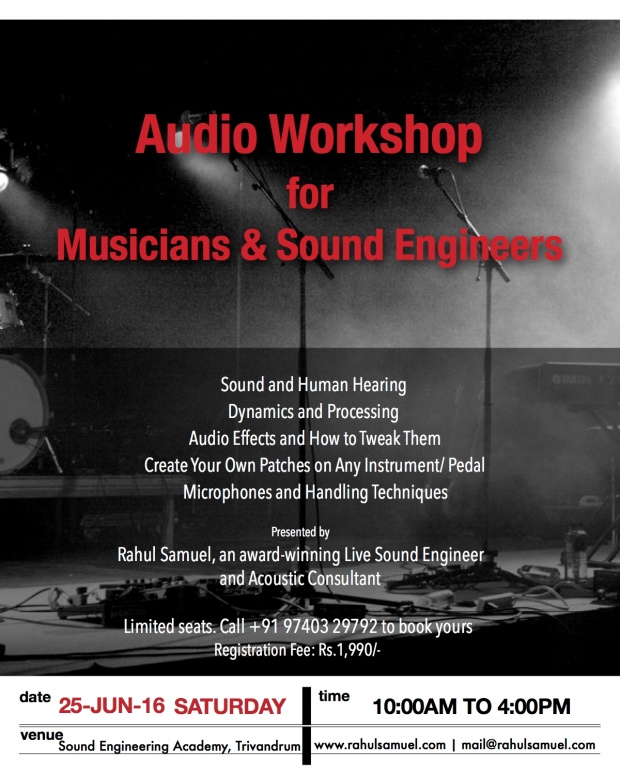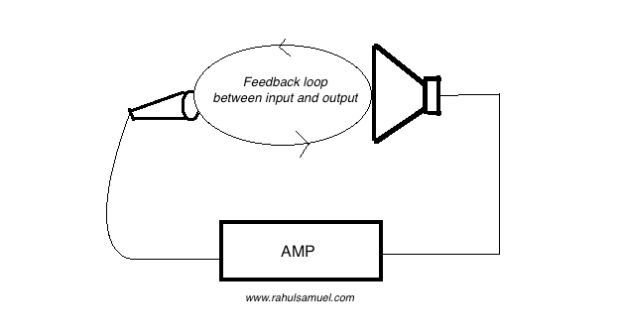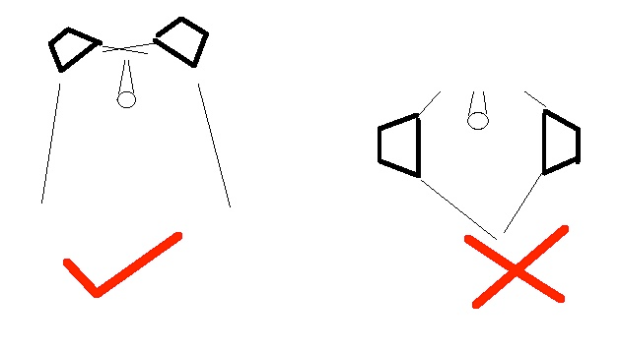Audio workshop in Trivandrum, Kerala, India on the 25th June 2016

Audio workshop in Trivandrum, Kerala, India on the 25th June 2016

Rock guitarists are known to use feedback as an effect but for most of us, it’s almost always considered undesirable.
Also known as Audio Feedback, Acoustic Feedback or Larsen Effect. It is a positive feedback loop that exists between audio input and audio output of a PA system.
By now, we have all experienced that the easiest way to cause feedback is to point a microphone (audio input) directly at a loudspeaker (audio output). This causes the preamp and amplifier to repeatedly amplify the sound of the loudspeaker picked by the microphone causing a ‘loop’ which we hear as feedback. Feedback occurs at one frequency at a time, but there could be multiple instances of feedback taking place at the same time at various frequencies.

A feedback loop
Now that we know a mic and speaker can cause feedback, let’s learn how to avoid it. There are four factors that come into play when we have feedback:
Let’s talk about each in detail.
This is one of the most effective ways to maximise gain before feedback. Any good live sound engineer would start by doing this first. As I mentioned earlier, feedback occurs at single frequencies. There may be multiple instances of feedback if you’re seeing more than one on your frequency RTA. These bumps where feedback happens is usually a by-product of the resonant frequencies of the ‘room’ and system.
Start with the right monitor-mic placement. As shown in the illustration below, it is best if the monitors face the back of the microphone.

Point monitors at the back of a microphone to minimise chances of feedback
1. Open a mic on stage one monitor at a time and slowly gain up till you begin to hear feedback, identify that frequency by ear (this takes some practice), or you could use a portable RTA like Phonic PAA3 or buy AudioTools by StudioSixDigital for iOS. RTA apps on android phones are not accurate but work fairly well only in quiet environments.
2. Reduce the identified ‘feedback frequency’ or the frequency closest to it by half a dB at a time on the graphic EQ for that monitor.
3. Repeat this process for all the monitors. Beware of cutting out too much or too many frequencies while you reach the limit of your system’s gain before feedback. By cutting out too much, you are essentially reducing the output level of the system.

Two instances of feedback occurs in this at around 45Hz and 250Hz. On a 31 band graphic EQ I would cut 40Hz and 250Hz as necessary
Being a live sound engineer has taught me many life lessons; one of those is ‘not having a tech rider is better than a bad tech rider’. If you came looking for this post, I don’t have to tell you what a tech rider is. It’s your band’s technical profile/requirement for the organizers, sound vendor and engineer to be prepared with stuff you need on stage.
Do you need one?
If you want to put a gig together without too many words flying around during sound check, yes. Tech riders are great, they not only bring the sound vendor and sound engineer up to speed, but also work as a brilliant check list for the band.
It’s your insurance policy in case the equiment is a mess. I am using some screen grabs from a tech rider I use for Swarathma, a band I frequently travel with.
What goes into a tech rider?
1. The line up
This gives a simple but precise overview of the band.
I got the Audio-Technica ATH-M50s/LE 50th Anniversary Edition about a year ago when it was time retire my old Sennheiser cans which I reviewed here. The Audio-Technica M50’s have been around for a long time and people swear by them. This is a straight cable 50th Anniversary Edition which is in a metallic silver-blue finish instead of the regular black-grey. In all other ways, it is exactly like the regular ATH-M50’s and has the same specifications.
It was a big leap from the budget friendly Sennheiser’s that served me for many years. I have used various headphones on the road including Beyerdynamic DT770 Pro, Shure SRH840 and more in the past few years, however I never tried an Audio-Technica ATH M50 which had numerous good reviews. Based on this, I had short listed the DT770 Pro and the Audio-Technica ATH-M50 as final options.
A reader asked me about sound check for a choir and acapella performances after seeing my blog post on sound check for bands. Because sound reinforcement for choral music works very differently, I realized the topic requires a separate blog post. I have worked with numerous gospel choirs and acapella groups and here are my observations on what usually goes wrong.
A few pointers before I dive in to the technicals:
1. Most musicians from choirs and acapella groups are also a part of rock/pop bands. They spend more time with the bands and assume things work the same way for a chorus on stage, but it doesn’t.
2. The reason you have a choir/acapella is because you intend to use ‘voices’ as an ‘instrument’. If you have an army of other instruments ‘backing’ your group, you better have voices that can be heard over them, of course without sounding like they are straining.
In all these years of gigging and traveling, I met many great musicians who were either partially or totally handicapped by technology. I tried to help many on stage, at the last minute, tweaking their tones and helping them with all the stuff that is “pro-audio”. I thank all those wonderful musicians who inspired me to come up with this special “Audio Workshop for Musicians” series aimed at enabling musicians to conquer technology and concentrate on music.